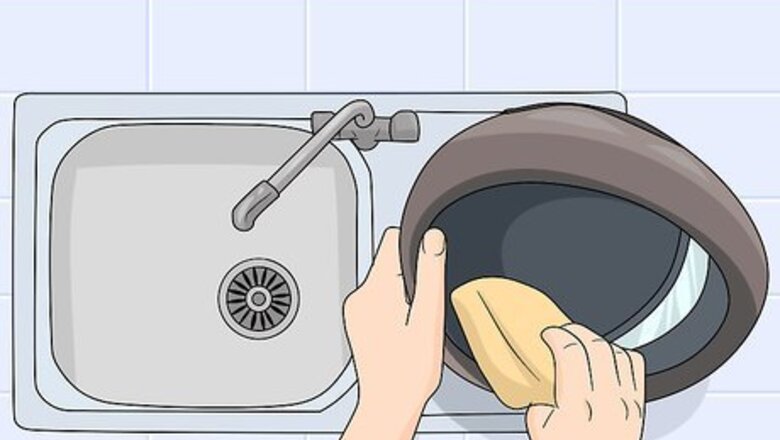
views
Washing the Visor
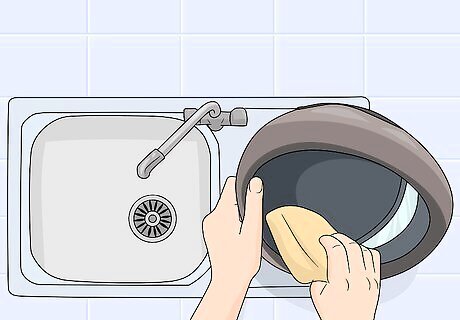
Set your helmet next to a clean sink and remove any padding. Remove items in your sink and set out a dry towel next to it. Place your helmet on the towel. Grab a mild dish soap and a wash cloth. If your helmet has any electronic systems or removable padding, take them out and set them aside. The exterior side of motorcycle and dirt bike visors are typically covered in a special anti-scratch coating. Some visors are also covered in another coating that reduces glare. Using a strong abrasive cleaner or chemical cleaning agent can destroy or erode these layers over time.}} You can use a special motorcycle visor cleaner instead of dish soap if you prefer.

Soak a wash cloth in hot water. Grab a clean, soft wash cloth. Turn the hot water in your sink on. Wait 2-3 minutes for the water to warm up to its hottest temperature. Then, hold the wash cloth under the water and soak it through. If the water is too hot for your hands, put on a pair of rubber gloves before doing this.

Drape the cloth over the visor for 3-5 minutes to soften dirt or dead bugs. Close the visor if it’s open. With the helmet sitting on the towel next to your sink, spread the towel out and hold the cloth by the corners at the top. Cover the visor with your wash cloth by draping it over the helmet. If the wash cloth looks like it’s going to slide off, stuff a towel under the chin to raise the helmet up a little. This will soften any dead bugs or clumps of dried dirt.Variation: If your visor is really nasty, you can soak it in hot water and mild dish soap for 3-5 minutes after removing it from the helmet. Make sure that you have an anti-fog shield that can withstand soap though before doing this. Consult your helmet’s instruction manual to determine whether your anti-fog shield can withstand soap. If you don’t have any residue stuck on your helmet, skip this step. Even if it looks like you could scrape or scrub the bugs and dirt off, don’t do it. You may end up scratching the visor.

Add a squirt of dish soap to a microfiber cloth and scrub gently. Remove the wash cloth that was draped over your visor and set it aside. Grab a clean microfiber cloth and run it under water. Add a coin-sized squirt of dish soap and gently rub the visor. Scrub back and forth across the visor horizontally and cover every section at least 2-3 times. Keep your visor closed while doing this. Don’t apply a lot of pressure while doing this. It should feel like you’re grazing the visor with your cloth. Any remaining layers of dirt or dead bugs should slide right off while you’re doing this.
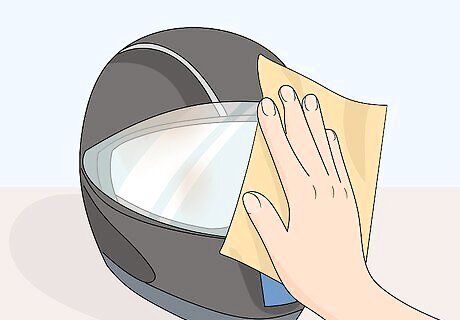
Rinse the dish soap off using a fresh wash cloth. Soak a new wash cloth in warm water. Rub the visor the same way you did with the microfiber cloth. Run the cloth over the surface of the visor using back-and-forth strokes. Continue running the wash cloth over the visor until all of the soap and bubbles are gone.
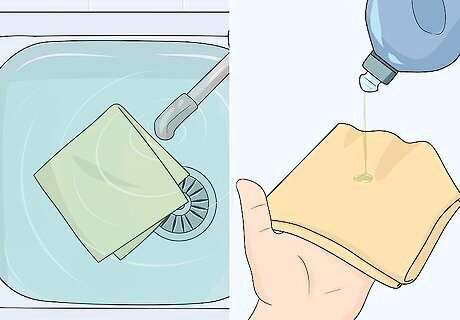
Dampen a microfiber cloth and add some baby shampoo. Grab a clean microfiber cloth and run it under warm water for 2-3 seconds. Grab a bottle of baby shampoo and squirt 1–2 teaspoons (4.9–9.9 mL) of baby shampoo into the cloth. Rub the cloth together to distribute the baby shampoo throughout the fibers of the cloth.
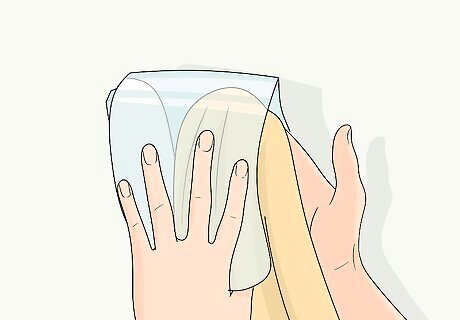
Rub the inside of the visor with your cloth using gentle strokes. With your cloth loaded with water and baby shampoo, put the cloth against the interior of the visor. Gently rub the cloth against the visor using smooth circular strokes. Cover each section of the visor 2-3 times to remove any dust or dirt. The shape of the visor can make it kind of hard to clean the corners where it attaches to the helmet. Luckily, it’s more important to clean the area in the middle of the visor where you look out of it. Don’t worry about minor residue near the corners if you can’t reach it.
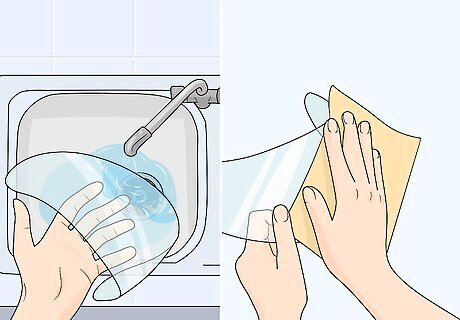
Rinse the visor off or rub it with a wet microfiber cloth. Take your visor off, if possible. If you can’t take it off, stuff the inside of the helmet with a clean towel. If you removed your visor, run it under a soft stream of water to rinse it off. If you did not remove the visor, load a clean microfiber cloth with water. Gently rub the inside of the visor to remove the baby shampoo. Continue reloading your cloth and wiping the visor until you don’t see any bubbles or shampoo residue.
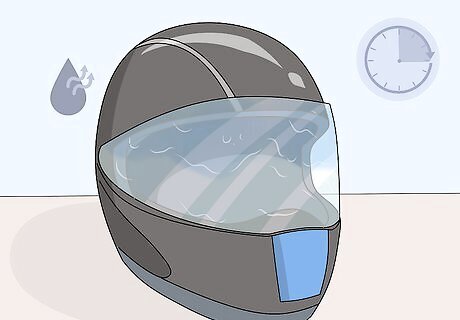
Let your helmet air dry for 2-3 hours. Set your visor out on the towel next to your sink. Set your visor up so that the visor isn’t laying flat. Let your visor air dry for 2-3 hours. If you removed your visor from the helmet, reattach it to the helmet after it is completely dry. So long as your visor is resting at an angle, it will dry properly. If it’s resting flat on the towel, water spots may dry into the visor.
Maintaining a Clear Visor

Use eyeglass cleaning tissues to wipe your visor down after every ride. It’s best to avoid using dry materials to clean your visor, but getting it wet can leave water spots. However, the moist towelettes designed for cleaning eyeglasses are perfect for wiping down helmet visors. After every ride, use a disposable towelette to wipe your visor down and remove any surface residue. You can use a special motorcycle helmet wipe if you prefer, but they tend to be much more expensive than the eyeglass cleaning tissues.
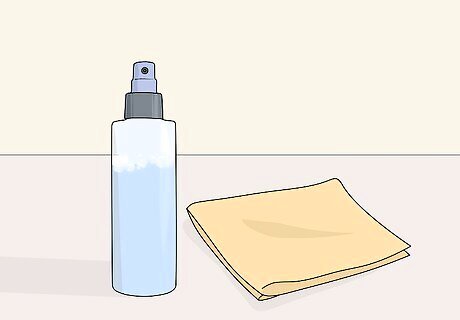
Keep a spray bottle and microfiber cloth on you for cleaning on longer rides. Over the course of longer rides, the gunk on your visor can build up and work its way into the plastic. To keep dirt from building up, keep a small spray bottle filled with water and mild dish soap on you. Spray the visor and use a clean microfiber cloth to wipe the water away when you make pit stops on long trips.
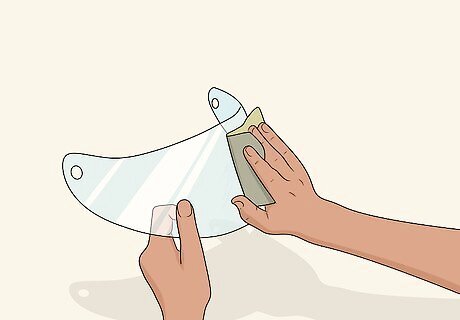
Sand the visor down to remove scratches. The only way to safely remove scratches is to sand the visor down. Rinse the visor and use 800- to 2000-grit sandpaper to sand the visor down. Work your way from the coarsest to finest sandpaper. Then, use a heat gun to heat the visor and smooth the surface out. This will remove any coatings, finishes, or anti-fog shields, though. Rinse the visor off after every layer of sanding to ensure that you don’t trap any small pieces of plastic in the visor. It is recommended that you simply replace visors that have been heavily scratched. It’s much safer to simply get a new visor than mess with an important safety feature of your helmet.

Avoid touching your visor with your hands to avoid smears. Even if you’re wearing gloves, your fingers can smear the dead bugs or gunk that builds up on your visor. Always carry your helmet by holding the base of your helmet and avoid touching it directly—especially when you ride. If you end up smearing things on your helmet while you ride, it can actually make obstructions worse. Always pull over to clean your helmet instead of knocking stuff off of the visor while you ride.
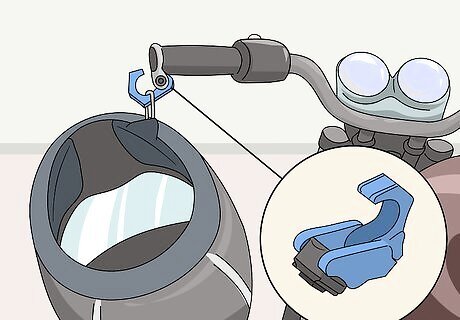
Hang your helmet on a helmet hook or stable surface to avoid dropping it. Most motorcycles have a designated helmet hook. If your bike doesn’t, install one on the handle. Hanging your helmet on the handle or mirror increases the odds that the helmet falls to the ground. If this happens, the impact can scratch or break your visor. Always keep the helmet on a stable surface to prevent falls or breaks. A helmet hook is a small clip that latches on to your handle. When you park, wrap the chin strap around the hook to keep your helmet stable.



















Comments
0 comment